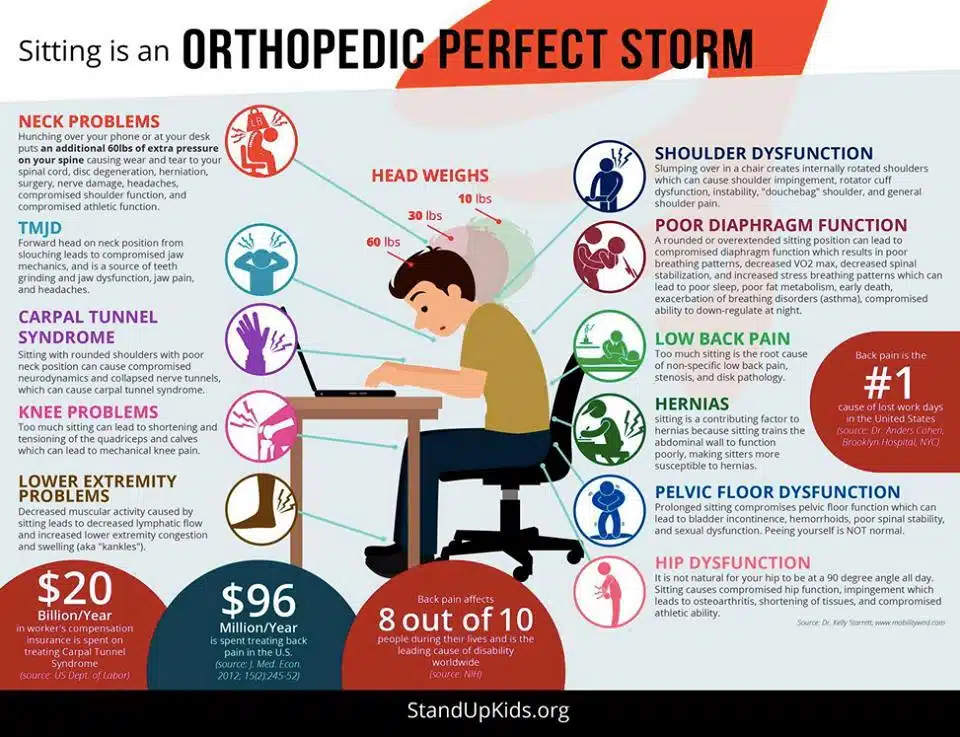Movement is the new black. With school starting back up, I am sure many people – from parents of young ones to college freshman and even those impressive grad students – have heard of “text neck.” There have been many posts going around about the position of a person’s head and the increase of force placed upon the neck.
While it’s true that an increase of force on the head and spine can lead to problems including headaches, shoulder pain, restricted movement, and low back pain, it isn’t the main cause of our problems. If you talked to older generations, they will tell you this is the same position they held their heads in when reading books (WHAT ARE THOSE?! Am I right, Millennials?). So if that isn’t the problem, what is? Sitting, or more importantly, the sedentary lifestyle has become the new norm. Within this back to school post, I won’t be talking about proper backpack wearing, or how much weight should be in the backpacks; rather, we’ll discuss positioning.
These days, there is an increase of childhood obesity, diabetes, and the average American waistline has expanded. A major factor seems to be that we, as a population, have developed a propensity for sitting. This applies to kids, who have a new video gaming console rather than a new baseball glove, to students, who are now going to graduate programs where they are spending a longer time sitting in classrooms, and to adults, were we have become so tech driven that more desk jobs have been created. Now you may be thinking, “So what, what’s your point? There isn’t anything that can be done.” But there is, and it starts with movement.
If you visit www.StandUpKids.org, you will find statistics and information supporting movement and you’ll even see a push for kids to have stand up desks (which many of my patients have implemented at work!). Below I have listed some informative statistics:
– Average U.S. student is sitting an average of 4.5 hours/day at school and (for kids ages 8-18) an additional 7 plus hours/day in front of a screen, regardless of socioeconomic status. Combine that with time spent doing homework, sitting at the dinner table, and driving to and from school, our kids are spending nearly 85% of their waking hours in sedentary positions.
– The World Health Organization ranks physical inactivity as the 4th largest killer globally, behind obesity.
– Since 1980, the obesity prevalence in children and adolescents has almost tripled.
This means that the more we sit, the more damage we are doing to our own body. So how do we fix it? A good start is to begin moving. Kelly Starrett, DPT, states as a rule that for every thirty (30) minutes of sitting, we should be doing four (4) minutes of moving. This means get up, power pose, open up the chest, stretch the hip flexors, and walk the stairs. Additionally, I’ve listed my two favorite exercises that will help for the neck and low back.
Bruegger’s position
– This can be done every hour on the hour to start and even more to improve posture.
– Bruegger’s position will start to take pressure off the neck by strengthening the deep neck flexors and the muscles between your shoulder blades while stretching out your shoulders.
Forward lunges
– Lunges will help open up the hip flexors and engage the core to take any pressure off the low back.
– These are a great warm up before performing exercises and are great beginning exercises to build on.
Lastly, for those with kids, encourage them to get outside and play. Who knows, maybe you will join them and find your inner child again!
I’ll leave you with an informative graphic about sitting and back pain, and I wish all those starting a new school year the best of luck! Keep moving friends, literally and figuratively!

http://www.npr.org/sections/thetwo-way/2014/11/20/365473750/keep-your-head-up-text-neck-can-take-a-toll-on-the-spine
http://standupkids.org
Starret, K. (2013). Becoming a Supple Leopard. Las Vegas: Victory Belt Publishing Inc.
